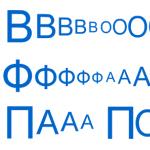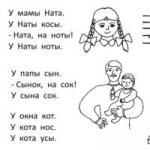Addition and subtraction worksheets are used to teach children to count or to test their skills in addition and subtraction. Different tables are used for these two tasks. Both versions of the tables can be downloaded and printed on this page
Addition table up to 20 print and download
The addition table is used to teach children. The vertical leftmost column and the horizontal top row represent terms. In order to add two numbers, you need to find them in a vertical column and in a horizontal row. The intersection forms the sum of these two terms. For example, as shown in the figure below, 6 + 5 = 11.
You can print the addition to 20 worksheet in Word or PDF format. If you need an addition table up to 10, you can easily make one by removing unnecessary cells in Word format. If you need an addition table for more than 20, then you can download the addition table in Excel format and add the necessary columns and rows by copying.
 |
|
 |
|
 |
Subtraction table up to 20 print and download
The subtraction table uses the same addition table that can be printed above. Suppose we need to solve the example 14 - 8 = 6. Using the subtraction table, we find in the table field the diagonal with the minuend 14. In the figure below, this diagonal is highlighted in light green. We choose the number 14 on this diagonal, which is opposite the subtracted 8. The resulting number 6 in the top row is the answer.

As you can see, the same addition and subtraction table is used for addition and subtraction, which you can print or download from the links above in different formats.
Subtraction table without answers print and download

 |
Good afternoon, dear readers! How much effort adults have to put in to teach a child to count within 10 and 20. And not only count, but also solve examples, subtract and add! At the same time, doing this is not as difficult as it seems at first glance. We offer you non-standard game techniques on how to teach your child to count examples within 20.
Where to begin?
Stage 2
If you have learned how to count, get acquainted with the graphic representation of the numbers. For this purpose, we use cubes with numerical images and cards.
Stage 3
The next stage is very important: it prepares the basis for quick mental arithmetic. This is the study of the composition of a number. If the baby knows exactly how numbers are laid out, he will easily solve addition and subtraction examples.
The study of the composition of numbers is traditionally carried out using so-called “houses”. Draw a house on checkered paper. There are always 2 cage rooms on one “floor”. The number of floors of a house is determined depending on the number of numerical pairs into which the number can be decomposed.
For example, 4 can be decomposed into 3 and 1, 2 and 2. This means that the number 4 lives in a two-story house, etc. We will write it on the roof. The example clearly shows how to correctly create houses for the numbers 3, 4 and 5.
The child will have to memorize the distribution of “tenants” by floor. Start with small numbers. Ask your little one to carefully look at who lives with which neighbor, and then “populate” the numbers yourself.
When two and three are mastered, move on to more complex numbers. This technique gives the most consistent results. Tested from my own experience.
Here you can download this table and use it to master the number composition technique: 
Stage 4
When the houses are completed, it is the turn of examples within 10. In the first grade, these examples will have to be solved in the first half of the year, so it is better to prepare in advance. Now all that remains is to place + or - signs between the “settlers”, having previously explained their purpose to the baby.
First, present addition or subtraction as a game. For example, from a four, a one left the floor. Which neighbor will remain on the floor? Answer: three. Such exercises will help the baby quickly get used to mathematical examples. Gradually we change the words “left” and “came” to “plus” and “minus”.

This is how we mastered counting within 10 with our child. As you can see, the technique is very simple, but it requires time and patience to work. Try to force your baby to count in his head first: written exercises slow down thinking.
Along the way, train the concepts of “more and less” (first use objects, placing them on different sides, then compare the numbers), neighbors of a number (write a series of numbers with missing digits and ask the baby to complete the series, placing the neighbors correctly).
Go ahead…
The time has come to introduce the baby to the second ten. To overcome arithmetic difficulties, we suggest the following training algorithm:
Part 1
We introduce the concept of ten. To do this, lay out 10 cubes in front of the child and add one more. We explain that it is eleven. We say that the ending of the word “dtsat” means “ten”. To form the number from 11 to 19, you just need to add the number to the ending “twenty” and put the preposition “na” between them.

Part 2
Since the baby is already familiar with the concept of ten, we introduce the units digit and operate with these concepts when adding. For example, 13+5. First we add the units: 3+5=8. Now add the remaining ten and get 18. 
Part 3
Now let's move on to the negative examples: we act in exactly the same way. Subtract the ones, then add the tens.
Part 4
The most difficult stage is subtraction, in which the first unit is less than the second: 13-6. In this example, we cannot subtract six from 3. You have to deal with dozens. One way is to subtract three from six, subtract the remaining number from ten, i.e. 6-3=3, 10-3=7. After a few practices, your baby will be able to do subtraction in his head.

The child must clearly master the described skills: in 2nd grade he will need this to solve examples with two-digit numbers.
To brighten up the learning process, you can use various aids:
- cubes;
- magnets;
- pictures (learning with pictures is especially varied: you can simply count them, use coloring books with examples to reinforce counting skills);
- any items at hand;
- counting sticks;
- abacus, etc.
The more imagination you show, the sooner you will interest your child in mathematics.
We have looked at the sequence of teaching your little one to solve examples within 20 in stages. If the article was useful to you, leave a comment or share the article with your friends on social media. networks.
See you soon, dear friends!
I already wrote about ours. But we seem to be growing out of it. In any case, Dima can freely count from 1 to 100 and back. I understand that his needs for mathematical knowledge are growing along with him. So I decided to delve deeper into studying mathematics using the Zaitsev system.
The table of one hundred has been familiar to me for a long time; even my older children had one. But Zaitsev has so many more interesting developments. The only BUT is that most of them require a lot of space. And we have a catastrophic shortage of it in our apartments.
At the dacha we finally made a room for ourselves. And, lo and behold, we have a large and not yet occupied wall! I immediately decided that I would hang it on her. I present to your attention our math corner at the dacha:
Addition and subtraction table within 20.
Number tape from 0 to 100.

True, according to the method, it should hang in one line, but we certainly don’t have such a long wall! My tables are slightly different from Zaitsev’s, but their essence is the same. I wanted to play with colors a little on the number strip. And making a colored background behind the numbers is, for example, very uneconomical for me when printing. In my opinion, it is enough that the numbers themselves are colored. And to the table of addition and subtraction within 20 I added the quantities of the main numbers - it seems to me more clear.
Tasks based on the tables can be read on Zaitsev’s website, where you can order original manuals. I offer what I made for my son. The documents will be in PDF format and must be printed on thick paper.

Addition and subtraction table up to 20 on 5 sheets, in which you need to trim the margins and glue the sheets together. I used regular tape and glued it on the back side.
Number tape on 22 sheets. The first two dozen fit on one sheet. They only need to be cut lengthwise and glued between 4 and 5, 14 and 15. From 20 to 59 everything is also clear. But the next dozen did not fit on one sheet in width, so you will have to work a little and think when gluing. I hope you can handle it.

Dima was very impressed with the new tables! He immediately noticed that on one table the numbers were black and orange, and on the other – green. He really enjoyed traveling along the number tape looking for the numbers I called out.
Addition and subtraction worksheets are used to teach children to count or to test their skills in addition and subtraction. Different tables are used for these two tasks. Both versions of the tables can be downloaded and printed on this page
Addition table up to 20 print and download
The addition table is used to teach children. The vertical leftmost column and the horizontal top row represent terms. In order to add two numbers, you need to find them in a vertical column and in a horizontal row. The intersection forms the sum of these two terms. For example, as shown in the figure below, 6 + 5 = 11.
You can print the addition to 20 worksheet in Word or PDF format. If you need an addition table up to 10, you can easily make one by removing unnecessary cells in Word format. If you need an addition table for more than 20, then you can download the addition table in Excel format and add the necessary columns and rows by copying.
 |
|
 |
|
 |
Subtraction table up to 20 print and download
The subtraction table uses the same addition table that can be printed above. Suppose we need to solve the example 14 - 8 = 6. Using the subtraction table, we find in the table field the diagonal with the minuend 14. In the figure below, this diagonal is highlighted in light green. We choose the number 14 on this diagonal, which is opposite the subtracted 8. The resulting number 6 in the top row is the answer.

As you can see, the same addition and subtraction table is used for addition and subtraction, which you can print or download from the links above in different formats.
Subtraction table without answers print and download

 |
In this lesson you will learn how to add and subtract single-digit numbers using place value. By solving interesting problems, you will study the algorithm for adding and subtracting numbers by passing through ten and get acquainted with the table for adding single-digit numbers up to 20. You will have the opportunity to practice the previously studied material using interesting examples.
Subject:Introduction to basic concepts in mathematics
Lesson: Adding and subtracting single-digit numbers using place value. Addition table up to 20
Using a graphical model, you can explain addition of single-digit numbers passing through tens.
How can you add 9 and 7?(Fig. 1)
Rice. 1
The graphical model shows that the first term 9 must be added to 10. To do this, we divide the second term into two parts, one of which is equal to the number 1, since
9 + 1 = 10, which means 7 = 1 + 6. (Fig. 2)

Rice. 2
Let's do the addition by parts:
9 + 7 = (9 + 1) + 6 = 10 + 6 = 16
Answer: 9 + 7 = 16.
You can add these numbers differently. (Fig. 3)

Rice. 3
The second term 7 can be added to 10. To do this, we divide the first term into two parts, one of which is equal to the number 3. Therefore, 9 = 3 + 6.

Rice. 4
Let's do the addition by parts:
7 + 9 = (7 + 3) + 6 = 10 + 6 = 16
The first term is 9, it lacks one unit to 10, so we break the second term into parts. 5 is 1 and 4. We add to 9 first one unit, and then the remaining four units.
9 + 5 = 9 + (1 + 4) = 14
The first term is 6, it lacks up to 10 four units, so we divide the second term into parts: 4 and 2. We add 4 to 6 first and get ten units, and then the remaining two units.
6 + 6 = 6 + (4 + 2) = 12
The first term is 4, it lacks up to 10 six, so we divide the second term 8 into parts: 6 and 2. We first add six units to 4 and get ten units, and then the remaining two units.
4 + 8 = 4 + (6 + 2) = 12
In the minuend 15 there are five units, so we divide the subtracted 7 into parts: 5 and 2. We first subtract five units from 15, we get 10. Then we subtract the remaining two units from ten.
15 - 7 = 15 - (5 + 2) = 8
In the minuend 16 there are six units, so we divide the subtracted 9 into parts: 6 and 3. First we subtract six units from 16, we get 10. And then from 10 we subtract the remaining three units.
16 - 9 = 16 - (6 + 3) = 7
In the minuend 12 there are two units, so we divide the subtracted 4 into parts: 2 and 2. From 12 we subtract 2, we get 10. And from 10 we subtract 2.
12 - 4 = 12 - (2 + 2) = 8
Answer: 12 - 4 = 8.
Using the method of addition and subtraction by parts with passing through ten is not always convenient, so you need to learn table for adding single digit numbers up to 20 by heart.
The figure shows a table that will make it easier for you to learn cases of adding single-digit numbers up to 20. (Fig. 7) 
Rice. 7
In each column, the first term is the same, and the second increases by one, which means the sum will also increase by one. Let's find the value of these amounts.
9 + 2 = 11, therefore: 9 + 3 = 12, reasoning this way, we fill out the entire table. (Fig. 8)

Rice. 8
Each line contains amounts with the same answers. Choose the way it will be easier for you to remember the answers: by columns or by rows. If you learn the table for adding single-digit numbers up to 20 well, then it will not be difficult for you to subtract single-digit numbers within 20.
Bibliography
- Alexandrova L.A., Mordkovich A.G. Mathematics 1st grade. - M: Mnemosyne, 2012.
- Bashmakov M.I., Nefedova M.G. Mathematics. 1 class. - M: Astrel, 2012.
- Bedenko M.V. Mathematics. 1 class. - M7: Russian Word, 2012.
- Social network of educators ().
- 5klass.net ().
- Self-taught ().
Homework
1. Remember how to correctly add and subtract single-digit numbers using place value.
2. Help the frog solve the examples.

3. Solve the examples and color the picture.




